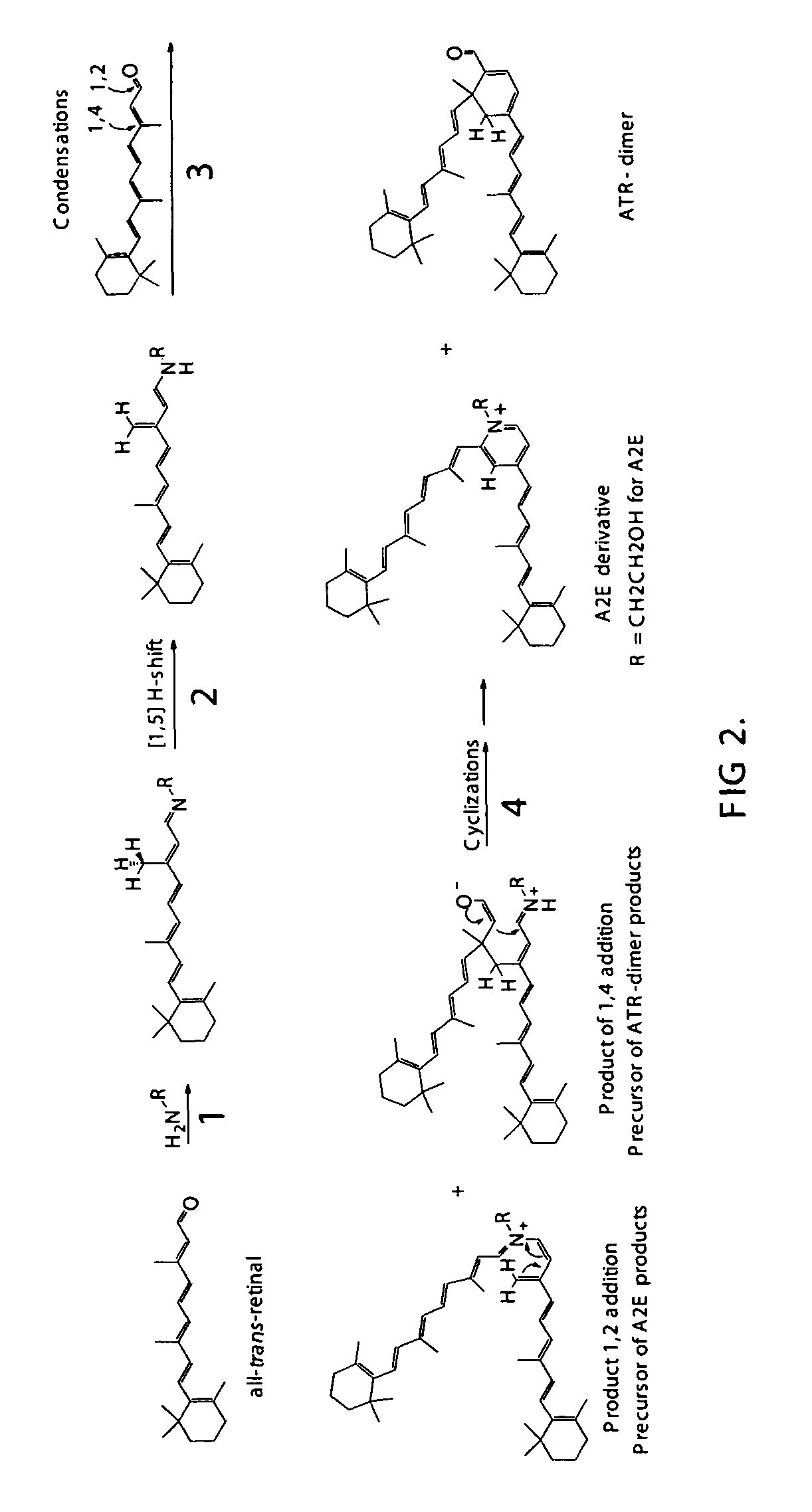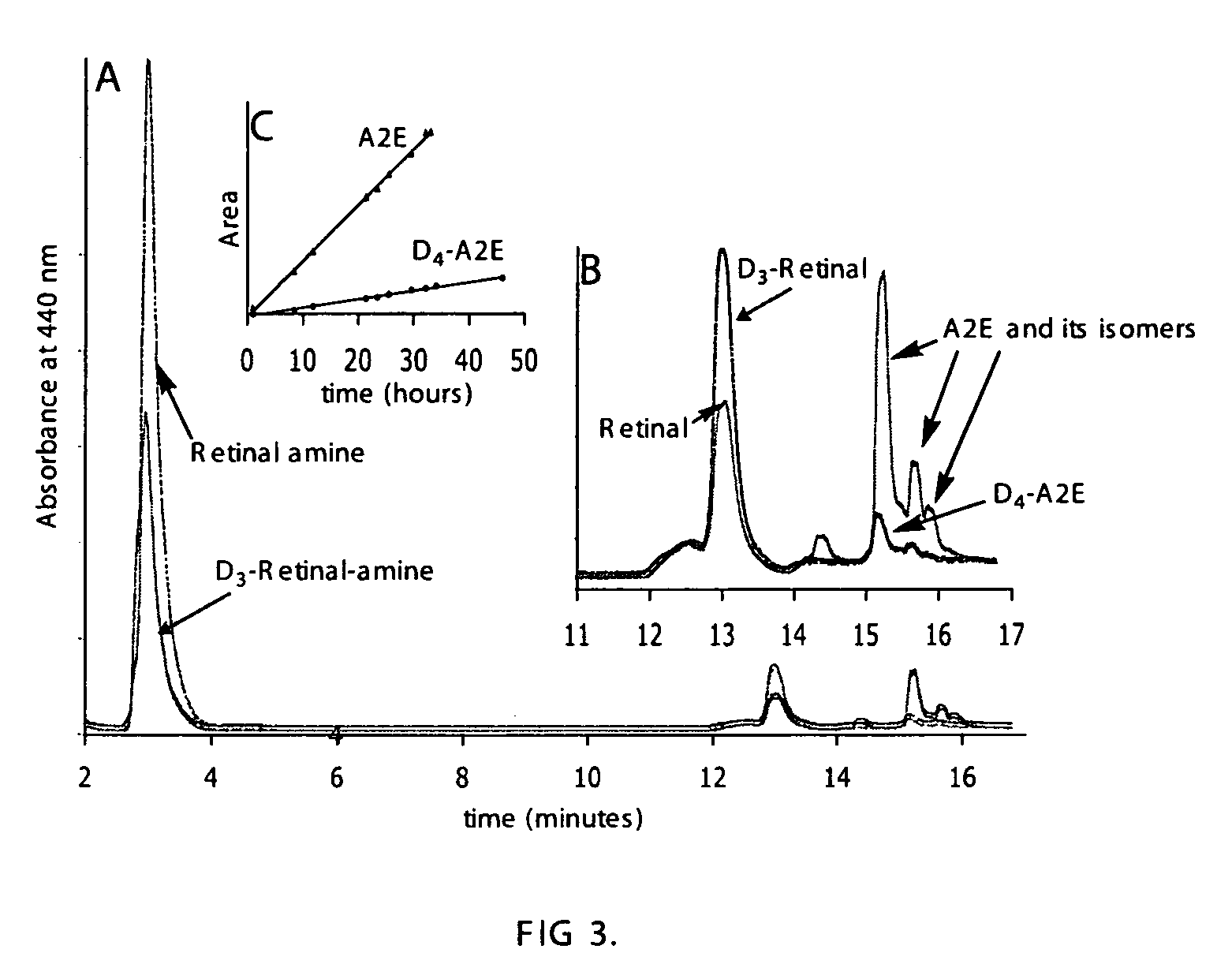Compositions and methods for treating macular degeneration
a technology of compositions and methods, applied in the direction of drug compositions, biocide, amide active ingredients, etc., can solve the problems of no current therapies for genetic or dry (non-neovascular) age related macular degeneration, severe delayed dark adaptation, and loss of central vision
- Summary
- Abstract
- Description
- Claims
- Application Information
AI Technical Summary
Benefits of technology
Problems solved by technology
Method used
Image
Examples
example 1
Replacing the C20 Hydrogens of all-Trans-Retinal with Deuteriums Slows the Formation of A2E In Vitro
[0110]C20-D3-retinal was prepared according to the literature procedure (47) and its in vitro ability to form A2E as compared to all-trans-retinal was measured by HPLC.
[0111]FIG. 3A plots the formation of all A2E for two reaction mixtures containing either all-trans-retinal or C20-D3-all-trans-retinal (16 mg), ethanolamine (0.5 equivalents) and acetic acid (1.2 equivalents). A typical HPLC trace is shown in FIG. 3B for the all-trans-retinal and C20-D3-all-trans-retinal reaction mixtures. The area under the curve corresponds to the amount of A2E: the larger the area the more A2E. The concentrations of A2E in the two reactions mixtures were measured about every 8 hours for 50 hours. The concentrations at each time point was plotted and the data points fit to a line for each reaction mixture. A comparison of the slopes of the two lines for the two reaction revealed that A2E formation occ...
example 2
Replacing the C20 Hydrogens of All-Trans-Retinal with Deuteriums Slows the Formation of ATR-Dimer In Vitro
[0112]C20-D3-all-trans-retinal was prepared as described in Example 1 and its in vitro ability to form ATR-dimer as compared to all-trans-retinal was measured by HPLC. All-trans-retinal or C20-D3-all-trans-retinal (10 mg) and proline (2 equivalents) in ethanol were mixed, and the reaction was followed by HPLC, the results of which are depicted in FIG. 4A. A typical HPLC trace is shown in FIG. 4B for the all-trans-retinal and C20-D3-all-trans-retinal reaction mixtures at the same time points. The concentrations of ATR-dimer in the two reaction mixtures were measured about every 15 min for 3 hours. The concentration at each time point was plotted and the data points fit to a line for each reaction mixture. A comparison of the slopes of the two lines showed that C20-D3-all-trans-retinal formed ATR-dimer 15 times slower than the unlabeled retinal as shown in FIG. 4C.
example 3
Replacing the C20 Hydrogens of All-Trans-Retinal with Deuteriums Slows the Formation of A2E-Lipofuscin in CD-1 (ICR) Mice
[0113]C20-D3-all-trans-retinal was administered to mice in order to measure its ability to form A2E in the eye compared to all-trans-retinal. Nine, 8-week old, CD-1 (ICR) mice (from Charles River, Wilmington, Mass.) were divided up into two groups of five and administered 1.5 mg of ether all-trans-retinal or C20-D3-all-trans-retinal by intraperitoneal injection (IP) injection in a 10% solution of Tween-20 in saline bi-weekly for 6 weeks. At the end of this six-week period, each mouse was given a total of 60,000 I.U.(18 mg) or about 28-times the original amount of vitamin A in the mouse's body. Massive dosing with C20-D3-all-trans-retinal quickly replaces normal vitamin A stores with the C20-D3-analog. And, the injected retinal rapidly accumulates in the eye (rod outer segments), where at high enough concentrations it will react to form lipofuscin pigments. This is...
PUM
| Property | Measurement | Unit |
|---|---|---|
| retention time | aaaaa | aaaaa |
| pharmaceutical composition | aaaaa | aaaaa |
| concentration | aaaaa | aaaaa |
Abstract
Description
Claims
Application Information
 Login to View More
Login to View More - R&D
- Intellectual Property
- Life Sciences
- Materials
- Tech Scout
- Unparalleled Data Quality
- Higher Quality Content
- 60% Fewer Hallucinations
Browse by: Latest US Patents, China's latest patents, Technical Efficacy Thesaurus, Application Domain, Technology Topic, Popular Technical Reports.
© 2025 PatSnap. All rights reserved.Legal|Privacy policy|Modern Slavery Act Transparency Statement|Sitemap|About US| Contact US: help@patsnap.com



